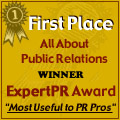|
by
Steve Turner
Principal, Solomon/Turner
 Young
public relations practitioners do it. So do many industry
veterans. They create and distribute one general news release to
a multitude of media and then hope for coverage in newspapers,
television, radio and online. Young
public relations practitioners do it. So do many industry
veterans. They create and distribute one general news release to
a multitude of media and then hope for coverage in newspapers,
television, radio and online.
Stop the presses! Newspaper editors, beat writers, television
producers and online editors all have different goals, needs and
deadlines. Your writing needs to be tailored to meet their
special demands if you hope to improve your chances for
coverage. Here’s how they work…
1. Newspaper. Editors and writers are most
interested in trends and timely stories that impact their
readership. They are usually juggling five or six stores at a
time in hopes of getting something done by an early evening
deadline. So to grab their attention your writing needs some
impact and the data to back it up.
If you have a new product, a new service, or spent a lot of
money developing one, you are on the right track. Ask yourself,
what makes this product so important and how many people in the
area, regionally or even nationally, will be impacted by it?
Then you can take the space to back-up your findings with a
right mix of data. Print reporters need projections and evidence
to solidify the story. They have the space to write about it.
Ensure you have some numbers in your release or pitch letter.
You can also create a meatier release for print than you can for
the electronic media. Though one page should suffice in most
cases, you have the option of adding a page if the story is
interesting enough.
2. Television. TV news is much different than
print. Any news producer or reporter will tell you that
television is a visual medium, so you need to think visually.
That new product launch, which might work well for print, better
have plenty of moving parts if you hope to land a spot on the
6pm news. Tieing it to an event with local celebrities,
dignitaries, children and/or pets is usually a good method to
generate some type of coverage.
Just like the news product itself, releases for TV need to be
short and concise. If your ideas can’t be confined to one page
they won’t be a good fit for television. Many producers will
tell you the shorter the news release, the better. If you can
keep it to less than a page, you score more points. In fact many
reporters would recommend utilizing a Who-What-When-Where
approach to the release with the main facts easy to find and
read.
3. Radio. While TV stations have two to three
key newscasts a night, news/talk radio stations have a report at
least once an hour. Just like television, writing for radio also
needs to be short and sweet. While there is no visual element
involved the opportunity for a good sound bite with a key
newsmaker or decision maker always enhances your chances for
coverage.
4. Online. The online news “monster” is an
entirely different story (pardon the pun). News may be updated
not only hourly but also by the minute. Stories are quickly
posted, digested, and archived. Therefore releases need to be
extremely concise and well packaged. Words should be punchy.
Sentences should have some impact.
Articles written expressly for online magazines and web sites
should be as brief as possible. Paragraphs should be easy to
read. Thoughts broken down in logical order.
In some cases your writing will need
to have some “legs.” Perhaps it will be published a month or two
down the road. No need for short-lived releases here. Instead
concentrate on a trendier approach and provide solid
information.
Tailoring your release to each medium may take more time and
effort, but the results will be well worth it.
Steve Turner is a Principal with
Solomon/Turner, a St. Louis public relations agency. Steve
has over 20 years experience in PR and specializies in working
with high-tech and emerging companies in both traditional and
social media.
Email:
sturner@solomonturner.com
More Articles |
Submit Your Article |
PR Subjects
About Public Relations Homepage
Contact Us
|



